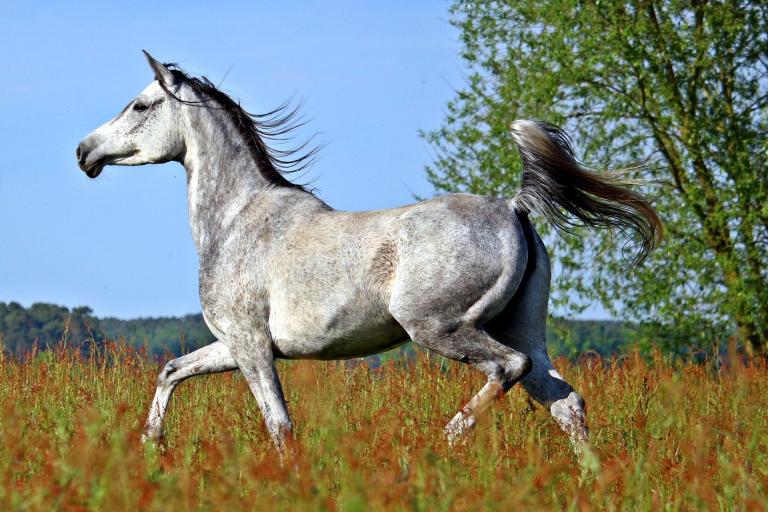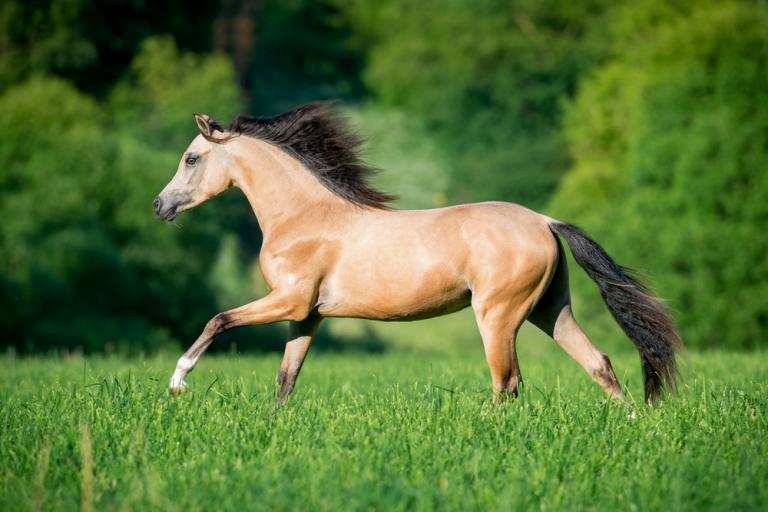Cerebellar Abiotrophy (CA Horse)
Cerebellar Abiotrophy (CA) describes ataxia in horses due to progressive death of brain cells responsible for movement. Affected animals show balance, coordination, and movement disorders, which pose a high risk of injury to both animal and rider. Depending on the severity, the animals suffer greatly from this disease, which is why euthanasia is often considered.
The disease occurs in Arabians and related breeds and is inherited autosomal recessively.
Genetic Test: available in Shop
Symptoms
- Balance and coordination issues
- Head tremors
- Occasional falling/stumbling
- Difficulties rising
- Wide-based stance
- Uncontrolled/overshooting movements
General Information
- Degeneration of Purkinje cells in cerebellum, with first symptoms visible as early as six weeks of age.
- Strongly variable severity of symptoms may impede diagnosis.
- Risk of injury is high for affected horse and handler → should be handled very carefully and not be used for riding/sports.
- Affected horses are often euthanized due to poor quality of life.
- The mutation is found in Arabians and related breeds. Because of the wide use of Arabian horses in many other breeds, it is recommended that riding ponies and light horses of many breeds be tested.
Beginning January 2019, all active riding pony stallions in Germany must be tested to be approved for breeding.
Breeds affected
Arabian Horses and related breeds
Test Information
Genotype and Lab Report
Inheritance: autosomal recessive
→ Only horses with two copies of the variant (ca/ca) are affected. Horses with only one copy (N/ca) are clinically healthy carriers.
Genotype
N/N = normal
The horse has no copies of the genetic variant causitive for CA and therefore cannot pass it on to its offspring.
N/ca = a carrier
The horse is clinically healthy. It has one copy of the genetic variant causitive for CA, which will be passed on to its offspring with a probability of 50%.
ca/ca = affected
The horse is affected and has two copies of the genetic variant causitive for CA. The variant will be passed on to its offspring with a probability of 100%. All offspring will be carriers.
Recommendations
- Carriers may be bred to normal animals (N/ca x N/N) without any risk of producing affected offspring. The offspring should also be tested before breeding to determine if they are carriers or normal.
- Breeding two carriers (N/ca x N/ca) is not recommended due to the possibility of 25% of the offspring being affected.
- Affected animals (ca/ca) should not be used for breeding.
Literature
Brault, L.S., Cooper, C.A., Famula, T.R., Murray, J.D. and Penedo, M.C.T. (2010) Mapping of equine cerebellar abiotrophy to ECA2 and identification of a potential causative mutation affecting expression of MUTYH. Genomics doi: 10.1016/j.ygeno.2010.11.006.
Further information is available at Online Mendelian Inheritance in Animals.


